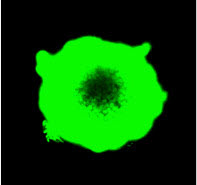In 3D cell culture models, cells are grown under conditions that allow the formation of multicellular spheroids or microtissues. Instead of growing in a monolayer on a plate surface, cells in 3D culture grow within a support matrix that allows them to interact with each other, forming cell:cell connections and creating an environment that mimics the situation in the body more closely than traditional 2D systems. Although 3D cultures are designed to offer a more physiologically accurate environment, the added complexity of that environment can also present challenges to experimental design when performing cell-based assays. For example, it can be a challenge for assay reagents to penetrate to the center of larger microtissues and for lytic assays to disrupt all cells within the 3D system.
Earlier this week Terry Riss, a Senior Product Specialist at Promega, presented a Webinar on the challenges of performing cell-based assays on microtissues in 3D cell culture. During the Webinar, Terry gave an overview of the different methods available for 3D cell culture, providing a description of the advantages of each. He then discussed considerations for designing and optimizing cell-based assays for use in 3D culture systems, providing several recommendations to keep in mind when performing cell viability assays on larger microtissue samples.
Terry began by describing examples of the main methods used to generate 3D cultures, which include both scaffold- and non-scaffold-based methods:
Scaffold-based methods discussed were those using natural hydrogels such as collagen and alginate, and others that use synthetic polymers. The advantages of animal-based materials such as collagen include the fact that it is a natural component of the extracellular matrix and so contributes to the biological relevance of the culture model. The downside of this is the potential for growth factor contamination and a higher risk of lot-to-lot variability. Plant-derived materials such as alginate are also used, and offer the advantages of freedom from animal contaminants and inhibitors, as well as providing more control over the size of the spheroids formed. Synthetic polymers provide advantages when a biologically inert scaffold is desired, and they also can be chemically modified as needed.
Non-scaffold-based methods covered included low-adhesion plates, micropatterned surfaces, and the hanging drop method. In low-adhesion plates, cells stick to each other rather than the plate surface, forming microspheroids. With micropatterned plates, spheroids are grown in microwells etched onto the plate surface. In the hanging-drop method, cells grown in suspension form their own extracellular matrix and accumulate as spheroids. Advantages of this method include the ability to control the size of the spheroid, reproducibility, and the ability to automate dispensing.
The culture method chosen depends on the model system being investigated, the desired sample number and throughput, and the experimental goals.
Assay Optimization for 3D Culture Conditions
After reviewing the various culture methods, Terry went on to cover the challenges of assay development for cells in 3D environments. Most cell based assays were developed and optimized on 2D monolayers in traditional cell culture. Therefore, optimization of assay conditions is required for use of these systems in a 3D cell spheroid. Typical challenges for 3D assay development include the ability of the reagent to lyse the sphere and penetrate to it’s center, and also concerns about quenching of the assay signal under the conditions required to lyse larger spheroids. Several examples are provided of ways in which assays may need to be optimized for success. These include options for using stronger detergents in products specially reformulated for use in 3D culture, and the use of longer incubation times. Data showing performance of cell viability assays, cytotoxicity assays and caspase assays in 3D model systems is presented in the Webinar. The webinar also contains useful links to more information on 3D culture methods and resources.
View the Webinar “Overview of 3D Cell Culture Model Systems and Factors to Consider When Choosing and Validating Cell-Based Assays for Use With 3D Cultures” for full details of the topics summarized in this post.
Isobel Maciver
Latest posts by Isobel Maciver (see all)
- 3D Cell Culture Models: Challenges for Cell-Based Assays - August 12, 2021
- Measuring Changing Metabolism in Cancer Cells - May 4, 2021
- A Quick Method for A Tailing PCR Products - July 8, 2019



a nice attempt!